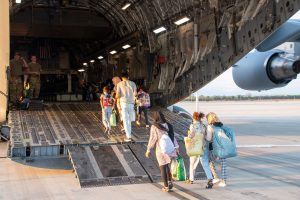A senior U.S. diplomat apologized Friday to thousands of Afghans stranded in the United Arab Emirates months after the fall of Kabul to the Taliban, promising to speed repatriation for some to America while acknowledging that authorities still do not know who some of them are.
The visit comes as America still struggles with how to handle the tens of thousands who piled into planes in the hectic final days of Afghanistan’s U.S.-backed government, capping the end of a 20-year experiment in replacing hard-line Taliban rule with a nascent democracy.
While vowing to do all they could, the diplomats who spoke to journalists afterward acknowledged still not being able to answer what would happen to some — and that the journalists, prosecutors, and others who made up civil society in Afghanistan might never get U.S. visas. Meanwhile, Emirati officials still must deal with thousands of angry Afghans who already have held protests over the uncertainty.
“I told them that I was really sorry it was taking so long and I was as frustrated as they were, frankly,” the senior U.S. official said. “But I also asked for their understanding of how hard we’ve been working to get the systems going.”
The State Department officials all spoke on condition of anonymity to a group of journalists at the U.S. Embassy in Abu Dhabi, citing the “sensitive and ongoing natures of the issues discussed.” But the uncertainty over whether some would ever get to the U.S. — and their fear that somehow they could end up back in Afghanistan — remains.
“The problem is nobody knows what’s going on,” said Ahmad Shah Mohibi, the founder of a group called Rise to Peace, which has been trying to help Afghans stuck there. “The U.S. has a moral obligation” to help them.
Around 12,000 Afghans remain stuck in Abu Dhabi, with some 10,000 at Emirates Humanitarian City and another 2,000 at Tasameem Workers City in the capital, Mohibi said. They represent a cross-section of those who fled the Taliban’s lightning advance in August, including journalists, judges, prosecutors, LGBT rights activists, and religious and ethnic minorities, he said.
Eight American citizens, as well as three permanent residents, also remain in the housing as they don’t want to leave their family members who do not have U.S. visas, Mohibi said. The U.S. officials did not dispute the figures or the descriptions offered by Mohibi.
Perhaps more problematic, some 2,500 former soldiers now in Abu Dhabi identify themselves as belonging to so-called “Zero” Units, Mohibi said.
“Zero” Units — or “Counterterrorism Pursuit Teams” as the Americans called them — had been organized and run by the CIA in the long war against the Taliban. They conducted what Human Rights Watch described as “abusive” nighttime raids that involved extrajudicial killings and airstrikes that sowed anger in Afghanistan.
However, the “Zero” Units served as a bulwark as American and allied forces mounted their chaotic evacuations from Kabul International Airport ahead of the final U.S. withdrawal on Aug. 30.
Asked about the “Zero” Unit personnel in Abu Dhabi, the senior U.S. diplomat said: “Nobody, nobody comes into the United States without full vetting. I don’t care who they worked for or what they did or didn’t do. That’s the best answer I have.” However, the vetting that the official described only involves biometric scans and medical checks, not checks on service records.
The official declined to discuss any possible communications with the CIA. The CIA did not immediately respond to a request for comment Friday.
Evacuation flights had been going on until November, but then suddenly stopped, leaving the thousands stranded in Abu Dhabi without any clear route out. Then there are tens of thousands more still stuck in Afghanistan, whom the Taliban initially promised could leave but now may be changing their mind.
The senior official also said that two measles outbreaks among the refugees, concerns over coronavirus vaccinations and later, CDC demands for full medical examinations had slowed down the process of getting Afghans to the U.S.
The official also stressed the UAE controls the two sites in Abu Dhabi and that a full survey of those here still has not been finished. The official also said that private flights approved by the White House in the months after the withdrawal also added more people to the Abu Dhabi facilities.
State media have shown images of Abu Dhabi’s powerful crown prince and the country’s de facto ruler, Sheikh Mohammed bin Zayed Al Nahyan, visiting the site last year, though visits by journalists have been few.
The senior official also repeatedly praised the Emiratis for their help.
“Frankly, the Emiratis have been generous,” Mohibi said. “The problem is the U.S. government is making the UAE look bad. They offered a hand to help … (but now the U.S.) are not helping their ally take the Afghans out.”
Also, the Emiratis may be getting concerned. At least two protests have broken out at Emirates Humanitarian City in recent months over Afghans being upset about being stuck. They’ve been asking for jobs to earn money to send back home and to move on, the senior official said.
But the senior official did choke up when discussing efforts to reunite a child separated from his parents and six siblings in the chaos of the Kabul airport after an Islamic State suicide bomber killed more than 170 Afghans and 13 U.S. service members. The official said she’d like to have refugees in the U.S. by August, but it remained unclear how that could happen.
“But honestly, I can’t tell you,” she added. “I mean, let me put it this way: The U.S. process is complicated and difficult and time consuming. We are doing our best to speed it up.”

































